SaaS Product Development: From a Fresh Idea To Powerful Execution
Delving deeper into building a SaaS application, the stages of SaaS product development, and possible challenges you can face as a new SaaS entrepreneur.
Join the DZone community and get the full member experience.
Join For FreeSaaS application development has been a hot topic in the software community for several years now. The idea of developing a product and then making money with it month after month seems very enticing. But what should a prospective SaaS business owner know before attempting to venture into this competitive market?
In the first part of our long read, we discussed the specifics of the SaaS business model, the benefits of running a SaaS business, and the main and additional revenue streams for monetizing a SaaS solution. Today we are going to delve deeper into building a SaaS application, the stages of SaaS product development, and possible challenges you can face as a new SaaS entrepreneur.
How to Launch a Software as a Service Business
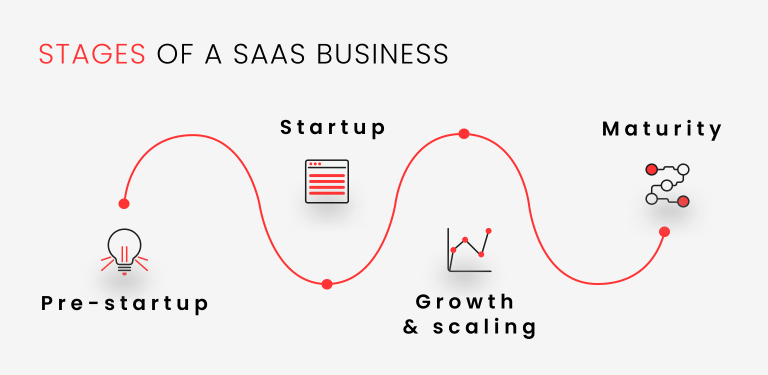
SaaS product development is a complex process, and even if you already have some experience in building SaaS or other software products, there is no guarantee that that experience will be enough to guide you successfully through the process. The exact sequence of steps depends on the product specifics, but certain things are universal for every SaaS application development project.
1. Conduct Market Research
“… You need to know your audience. You need to solve a pain point for them, and ideally, it’s going to be a pain that they are just dealing with without even seeing it as a problem.”
Andy Ide, Founder of HorseRecords
This step, ideally conducted by a business analyst or someone with extensive experience in the SaaS industry, can bring you a lot of valuable insights: whether your business idea is actually good, which business model is the most effective one, who your closest competitors are and what makes them stand out, and which industry and field you should be working in.
“In my experience as a Delivery Manager, I’m witnessing significant growth in two SaaS domains. The first one is healthcare, where both patients and providers want to simplify the operations, make them more autonomous, and further improve the telemedicine field. The other one is eCommerce, where individual entrepreneurs and small businesses can take advantage of the SaaS technology instead of developing expensive proprietary software.”
Mykola Pyvovarov, Delivery Manager, QArea
2. Define the Requirements
Once you know for a fact who your future SaaS product is for, it’s time to select the requirements that are crucial for your solution. For example, you should consider how many users your application should be able to serve at once, whether it’s going to need any security mechanisms that are stricter than usual, whether the customer will be able to modify the selection of features or the application will be distributed as-is, and so on. This will impact your business model, software architecture, and other parameters.
3. Assemble the Team
A lot of your future success as a SaaS business owner rides on the functionality, quality, and security of the software. This is why the actual job of SaaS software development should be entrusted to a team with proven expertise and industry knowledge. Unless you have a complete team of experts at your disposal, assembling a dedicated team with a product mindset can also be a great solution. You may need software developers, QA engineers, a business analyst, a project manager, UI/UX designers, and possibly other team members.
“To me, one of the most integral members of a SaaS development team is a product owner, who is responsible for the big picture and chooses the direction of the process. It’s even better when the product owner is working on the development team’s side — that way, they are perfectly aware of how the work on the project is going and can successfully communicate the needs of the developers to the business owner and vice versa.”
Olexii Pavliuk, Delivery Manager, QArea
4. Develop an MVP
Developing a prototype or an MVP is something usually reserved for startups. Still, even established companies can benefit from creating a lean MVP and later developing it into a fully functional solution. An MVP is a cost-effective, savvy way to ensure the viability of your business idea, better define the functionality and audience of the product, and avoid the situation where you invest too much money in an idea that does not resonate with the customers at all.
5. Develop the Product
The next big step is developing a full-fledged SaaS solution that is based on the MVP and the lessons learned at the previous stages. By this time, you and your team need to have a complete understanding of what the product should do, how you are going to market and distribute it, how to attract customers and how to make them stick around, and so on. This is the stage where the expertise of your development team plays a crucial role, as they are the ones who can deliver a flawless product with optimal use of your resources.
“Once the product is ready, businesses should consider marketing their SaaS solutions to potential customers to reach out to the right target audience. Companies should leverage both digital and traditional strategies such as social media campaigns, email outreach, content creation, targeted advertising, and more.”
Benjamin Okyere, Founder at StressReliever
6. Maintain and Improve the Application
As soon as you close the deal with your first customer, you sign up for continuous support and maintenance. The exact terms of the support can be stipulated by the user agreement or depend on the payment plan. However, it’s your responsibility as a vendor to provide customer support and to maintain the application in optimal condition. Moreover, to avoid stagnation, it’s essential to regularly update the application, unveil new functionality, improve the look and usability of the app, and extend its availability on different platforms.
“One of the best ways to know where the product is standing with customers, what works and what doesn’t, and see all the possibilities to improve it is to use customer feedback. However, most users will only leave feedback when they are extremely dissatisfied with the product. And the number of users who take the time to leave positive feedback is even lower. This is why making the feedback collection mechanism as easy, streamlined, and quick for the user as possible is vital. Offering rewards in exchange for feedback is also a good idea.”
Mykola Pyvovarov, Delivery Manager, QArea
How To Choose the Right Tech Stack for Building a SaaS Product
There are two important things to know about the tech stack for SaaS application development. First, there isn’t a one-size-fits-all technology stack that is equally applicable to every single SaaS project. Second, the technologies you use for developing a SaaS solution determine many of its key points, from functionality to performance and scalability.
At the same time, Olexii Pavliuk, our Delivery Manager, believes that the choice of a tech stack isn’t the most important choice a SaaS product owner has to make simply because it’s possible to accomplish the same goals by using different sets of technologies.
Before you and your development team make any choices regarding the technology stack, answer some questions about your SaaS idea and your plans for executing it:
- How complex is the solution going to be, and how much functionality is it going to include?
- Are there any tight deadlines to follow?
- What is the projected number of users right after the launch and a year from then?
- Is the solution going to be primarily available on desktop devices, or is mobile presence also an important feature to have?
- What comes first, the technical finesse of the solution or meeting your business goals?
- Are you planning to regularly add new features to the product, or is it going to be distributed as-is throughout its run?
- What kind of a skill set does your development team possess, and are you going to need to hire additional personnel to implement your ideas?
- What is the easiest, least resource-intensive way to bring your ideas to life?
- Is your product going to require special licensing or standardization — for example, if you’re working in the healthcare or government segment?
- Do you consider the learning curve and community support to be important factors for selecting the tech stack?
It goes without saying that unless you, as a product owner, have deep technical knowledge, some of these questions are impossible to answer on your own. This is why we are once again stating the importance of having not just a brilliant SaaS business idea but also an equally brilliant team to execute it.
A SaaS software product usually consists of the front-end, back-end, server, and database parts. Popular options for the front-end part of the application include JavaScript-based frameworks such as Angular, React, and Vue.js, which are perfect for developing browser solutions with universal accessibility.
For the back-end part, many developers choose PHP for its relatively easy learning curve and due to the fact that PHP developers typically cost less to hire than other back-end engineers. Other popular choices include .NET, Node.js, and C#.
The choice of database and server technologies primarily depends on the skill level of the development team and what is expected of the solution at the end of the development process. Moreover, many SaaS developers now choose in favor of mobile-friendly technologies such as React Native, Flutter, and Ionic, given that the number of mobile SaaS users is constantly growing and users have come to expect spotless mobile performance as a feature.
“The idea always comes first, and the execution follows the idea. The developer does not explain to the UI/UX designer or business analyst how the application is going to work — it’s the other way around. The UI/UX specialists fully conceptualize the look and logic of the application, and the development team must find a way to make it happen.”
Olexii Pavliuk, Delivery Manager, QArea
Stages of a SaaS Business
When it comes to SaaS business development, there are different approaches to dividing the process into stages. Some approaches are based on funding stages, while others measure the current stage of a SaaS business by the number of customers or the amount of revenue. However, the most common approach divides the SaaS development process into four stages: pre-startup, startup, growth & scaling, and maturity. Here is what you should know about these four stages.
Pre-Startup
This is the initial stage of the SaaS development process. At this stage, the team behind the product conceptualizes the idea and seeks the answer to the question: “Which customer problem is our product going to solve?” This stage can include assembling the core team, communicating with prospective customers about their pain points, establishing business relationships, securing funding, prototyping the solution, and building the MVP.
At the pre-startup stage, it’s crucial not just to develop a strong SaaS idea but also to identify the business models that will support it. Moreover, when the team receives the initial funding, it’s vital not to overspend it on non-essential things and not to depend on it for too long.
Startup
The startup stage is also often referred to as the product/market fit stage, as finding the perfect product/market fit is the primary objective at this stage. While at the startup stage, the owner should also be able to offer the customers a usable version of the product and see if the customers engage with the product and if the acquisition process goes as planned.
At the same time, the startup stage doesn’t rule out pivoting to achieve the perfect product/market fit. This is not the stage to think of growth and scaling; this is the stage to finalize the functionality, look, and target audience of the product to ensure adequate development in the later stages of the process.
Growth and Scaling
The SaaS growth stage is the stage where you can stop for a second to pat yourself on the back for getting this far but then quickly return to working just as hard as you did before or even harder. By this time, SaaS companies already have a stable revenue stream and effective ways to attract leads and turn them into customers. Turning revenue into profitability is one of the most important steps in a SaaS growth strategy.
The other important step is scaling: attracting new customers and increasing the capacity of the application to make sure it can handle the increased usage. Companies often require additional funding at this stage. However, it’s vital to maintain the right balance between scaling speed and expenses, as there is a risk of trying to scale too early and losing investor money as a result.
Maturity
This is the fourth and final stage of SaaS product development, and it’s usually the longest one. At this stage, the team behind a product can say with confidence that they’ve made it. There is a stable product, a loyal customer base, and a predictable revenue stream that generates profit for the company.
The growth may slow down at this point, but it should not stop completely; otherwise, the business may stagnate. If projections show that achieving significant growth in the domestic market may prove challenging or impossible, the team may want to focus on venturing into foreign markets, provided that there is a thorough understanding of the specific market requirements, regulations, and even unwritten rules.
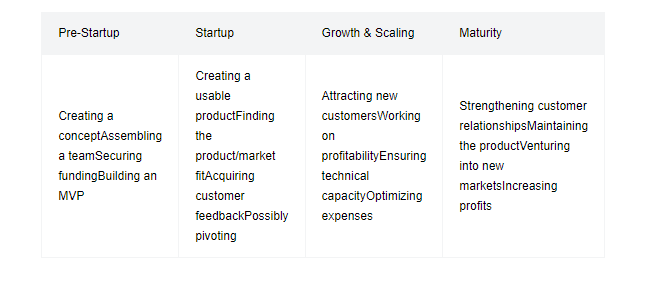
Important SaaS Metrics to Track Success
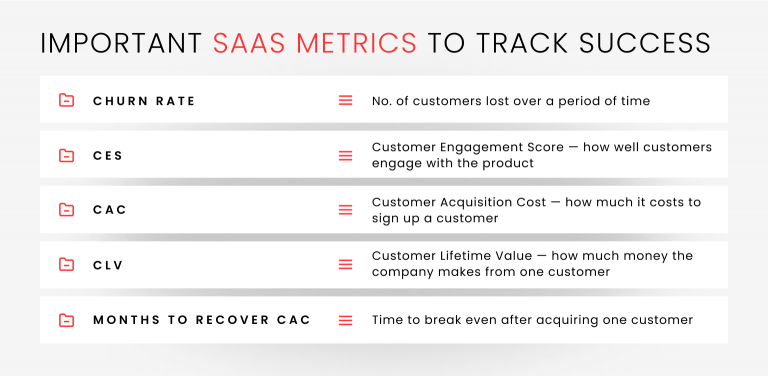
Like any other business, a SaaS business has a selection of metrics that demonstrate how well the product is doing and show the areas that can be improved. Tracking those metrics is an essential part of running a SaaS product development business while ignoring them will lead to the owner losing track of the state of the business and having to deal with increasingly complex issues.
The exact set of SaaS metrics depends on the specifics of your solution, such as the industry, complexity, business model, and time in the market. However, some metrics are universally applicable regardless of the project parameters. Here are the key metrics for SaaS to track when running a SaaS business:
- Churn rate. This metric refers to the number of customers your business lost over a specific time period. A steady churn rate is to be expected, but when there is a significant drop over a short period of time, it’s definitely something to discuss with the team.
- CES. CES, or Customer Engagement Score, is a metric that demonstrates how much and how exactly your customers engage with the product: how often they launch the application, which features they are using, how much time they spend interacting with your app daily/weekly, and so on. The logic here is that the more actively the users are engaging with your solution, the less likely they are to churn.
- CAC. CAC, or Customer Acquisition Cost, is one of the essential metrics for new SaaS businesses. It demonstrates how much exactly it costs for the company to acquire one user and is calculated by adding up all the money you’ve spent on sales and marketing and dividing that number by the number of acquired customers.
- CLV. CLV, or Customer Lifetime Value, is the total amount of money a single customer brings to your company for all the months/years of using it. This metric shows you what your average customer is worth to your company so that you can plan your marketing and sales spending accordingly. For a startup, this metric can also demonstrate the viability of your business to a potential investor.
- Months to recover CAC. This metric is responsible for calculating how many months it takes the company on average to break even after acquiring one customer. For example, if you’ve spent $5,000 on acquiring the customer and their total bill comes down to $500 per month, you will start making a profit from that customer ten months after the acquisition date. Ideally, the longer you spend in the business, the lower this metric should become.
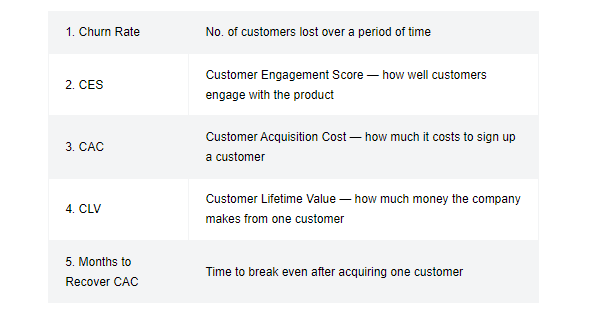
SaaS Growth Best Practices
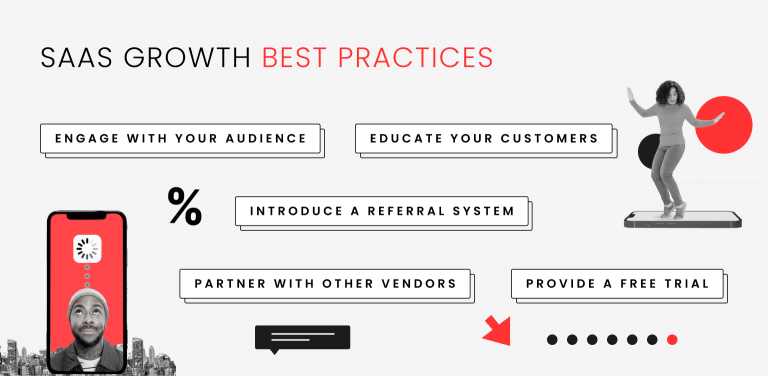
A brilliant SaaS business idea and an equally brilliant execution can create an innovative, powerful product. However, without an effective SaaS growth strategy, all the time and effort spent on SaaS application development can go to waste. Here are the best practices, tips, and hacks for SaaS growth:
- Engage with your audience. In order to be trusted by customers, you first need to be recognized by them. One of the most effective ways to do it is to build a loyal community around your brand on LinkedIn or another social media site. Your social media presence has to provide a lot of value to its members, so avoid making the content overly promotional. You can also offer freebies and exclusive deals to your subscribers.
- Provide a free trial. Free trials are one of the best ways to convince customers that your product is worth their time and money. Users are not very likely to pay a substantial amount of money for an unknown product from the get-go, especially if it’s completely unique and doesn’t have close competitors. A 14 or 30-day free trial works wonders for customer acquisition.
- Introduce a referral system. Referral systems allow a SaaS business to kill two birds with one stone: increase the loyalty of existing customers with the help of rewards and grow the customer base with referrals. The reason why referrals work so well is that a potential customer is much more likely to trust someone they know personally than an unknown brand. And the fact that it costs you significantly less than other forms of promotion is a nice bonus.
- Educate your customers. A customer who is well aware of the specifics and benefits of your product makes a more loyal user than someone who discovered you out of the blue. These days, there is no shortage of education opportunities, from webinars and podcasts/interviews with industry leaders to recruiting brand ambassadors and allowing them to do the educational work for you while promoting the brand.
- Partner with other vendors. Collaborating with other software vendors may seem counterintuitive when it comes to promoting a SaaS business, but the key here is to pick products that work in the same field but are not your direct competitors. Together, you can create discounted bundles and offer the customers more bang for their buck while getting your brand better recognition.
Possible Challenges of Developing a SaaS Business
By all accounts, SaaS application development is one of the most attractive software niches to join right now, and the current rate of SaaS growth will only continue. But that is not to say that SaaS business owners don’t face their own challenges or that every SaaS business idea is bound to survive and become a never-ending source of revenue for its owner. Here are the most common SaaS business challenges owners can potentially face:
- Customer retention issues. When you have a powerful SaaS business idea, convincing customers to give your product a try isn’t the hardest thing to do. The hard part is to get them to stay. Product owners can use a variety of methods, from offering bonuses and freebies to long-time customers to regularly updating the application and adding new functionality. Releasing a product and then sitting back and relaxing for a few years is not a good SaaS growth strategy.
- Security compliance. These days, customers trust SaaS products with the most sensitive information, from client data to financial management. Moreover, many SaaS products operate in industries that require strict compliance with security standards, laws, and regulations. This creates an additional challenge for SaaS companies operating in those domains, as just one misstep can derail years of development.
- Wrong choice of monetization models. A SaaS business needs to generate revenue for its owner, but there are several ways to make money with a SaaS solution, and they are not interchangeable. When the most appropriate business model is to provide ad-supported free access, and you are trying to sell the product through a paid subscription, it’s going to make users look for an alternative solution.
- Wrong choice of technology. We’ve already talked about the importance of the right tech stack earlier in this article, but it simply cannot be overstated. The technological stack impacts the look and feel of the application, its functionality, performance, security, scalability, and other essential parameters of a SaaS product. When your solution isn’t able to accommodate the growing number of users due to poor scalability, the wrongly selected tech stack is to blame.
- Regular acquisitions. Market consolidation is one of the leading trends in the software industry, with tech giants acquiring various software products, including SaaS, day in and day out. And when a product from your niche gets acquired by someone like Microsoft or IBM, with nearly unlimited resources for growth and development, the balance of power in the niche shifts completely.
The Biggest SaaS Trends: Where Do We Go From Here?
“At present, there does not appear to be anything that could replace Software-as-a-Service, as many businesses continue utilizing this technology due to its numerous benefits such as cost savings, scalability, efficiency improvements, and agility when compared against traditional models like on-premise deployment methods or managed services offerings.”
Jamie Irwin, Director & Search Marketing Expert at StraightUpSearch
Software as a Service is one of the most rapidly developing industries that has come a long way since its inception. Every year brings several new noteworthy trends to the SaaS industry, and this year, although it’s just started, is no exception. Here are the five SaaS trends that will shape the industry in 2023 and can help you make the right decision regarding the future of your project:
- The rise of micro SaaS solutions. This trend proves that you don’t need a large and complex solution to venture into the SaaS business. Even a small solution that is based on a unique idea that resonates with customers can successfully kickstart a SaaS business. It can be something as seemingly simple but indispensable as a browser extension.
- AI as a feature. Artificial intelligence has been one of the key selling points in many successful SaaS solutions over the past few years, but these days, customers have come to expect AI to be more heavily featured in their favorite products. AI use can include anything from replacing the background in a photo to writing copy for different purposes based on the prompt.
- The growth of vertical SaaS companies. The battle between horizontal and vertical SaaS structures has been one of the most prominent ones in the industry and it’s expected to continue in 2023, with the vertical SaaS model catching up in popularity. Many SaaS vendors now feel that focusing on one industry instead of spreading themselves too thin across multiple industries is the more effective strategy.
- Gradual shift to PaaS. SaaS solutions provide customers with a quick way to satisfy their business needs. However, to some customers, especially at the enterprise level, Software as a Service proves to be limiting with time. Platform as a Service solution, on the other hand, is more flexible and suitable for wide customization and scalability, which is why they are now the preferred choice for many customers.
- Creative marketing strategies. Developing a SaaS solution isn’t overly complicated, especially when you have a reliable team of developers on your side. However, with so many great SaaS solutions out there, it’s the distribution of the product that can often prove to be challenging. And regular promotion methods such as Google and Facebook ads are expensive and don’t always help reach goals fast. This is why SaaS companies now actively invest in SEO, content marketing, and out-of-the-box marketing strategies.
“I strongly believe that every SaaS company can benefit from an experienced marketing specialist with relevant industry experience. Sure, the development team can implement a few plugins for better SEO visibility, and you can also use the services of an SEO specialist. However, only a marketing specialist can design the most effective promotion strategy, ensure rapid growth, and decrease churn rate.”
Mykola Pyvovarov, Delivery Manager, QArea
Final Thoughts
Although the Software as a Service market is definitely a saturated one, and there are tons of fantastic applications already, there is always room for newcomers. The main requirements for making it big in the SaaS market are a strong application idea, an experienced team that will execute that idea, and deep knowledge of the market to design the most effective growth strategy. Hopefully, our tips and insights will help you turn your SaaS business idea into a product recognized for its quality and innovation.
Published at DZone with permission of Anna Smith. See the original article here.
Opinions expressed by DZone contributors are their own.

Comments